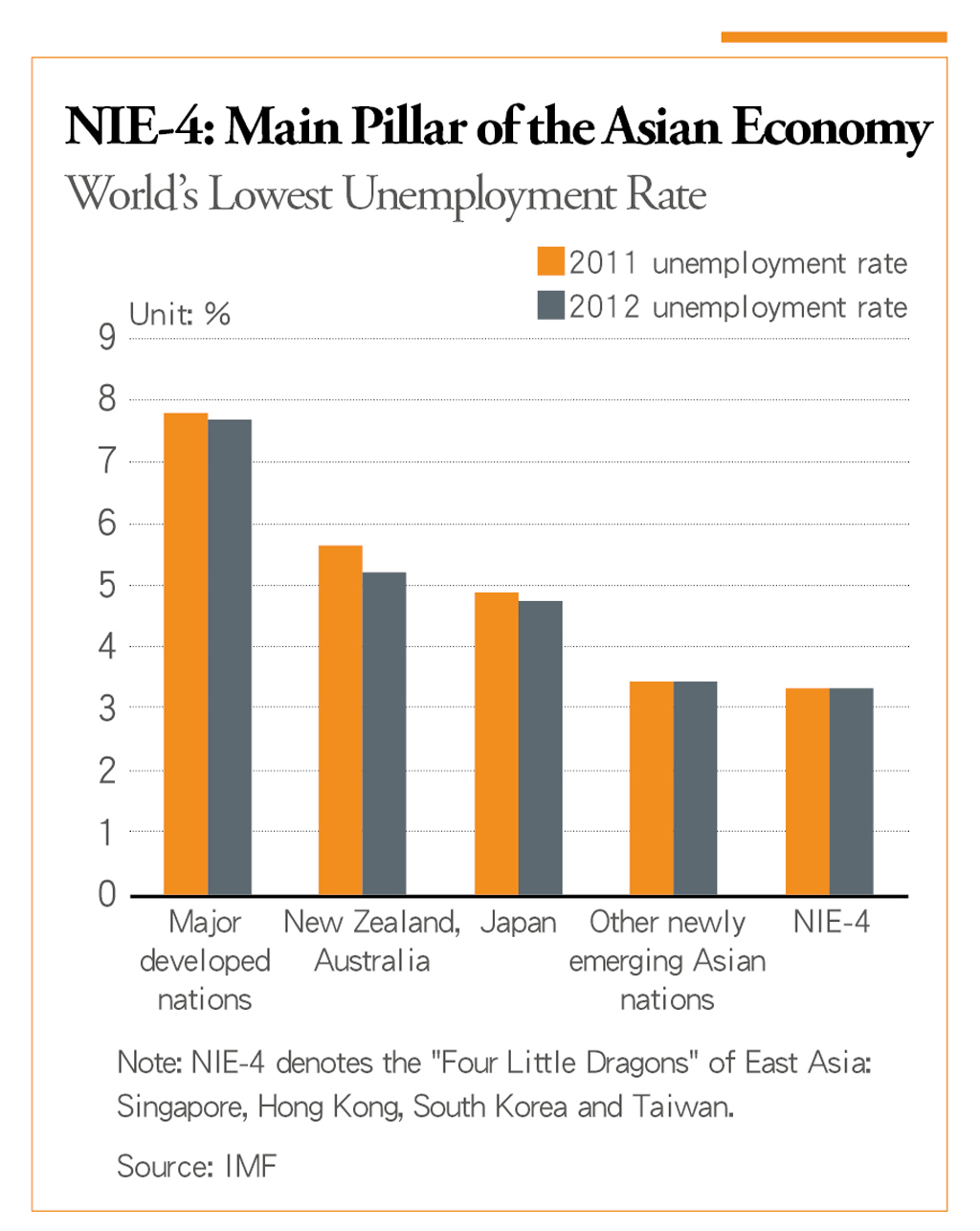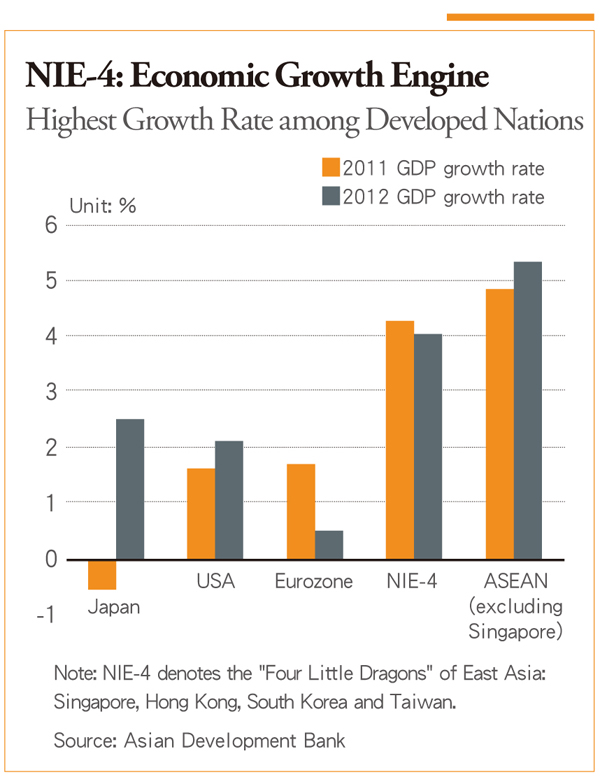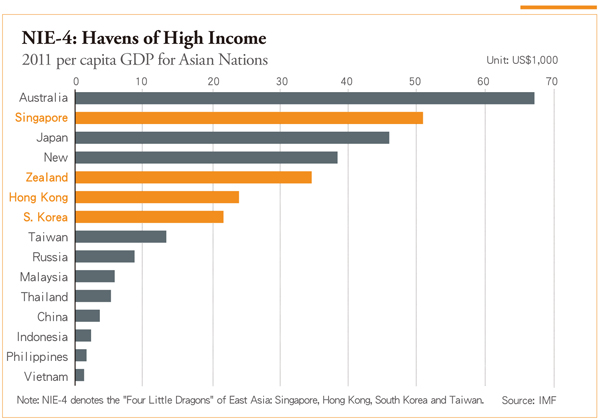The Four Newly Industrialized Economies
Stars of the Asian Century

Source:Ming-Tang Huang
The Four Little Dragons of East Asia have grown up. From centers of contract manufacturing, they have metamorphosed into centers of finance and trade – the "NIE-4" of Asia. But how can they parlay their wealth into equity and happiness?
Views
Stars of the Asian Century
By Elaine HuangFrom CommonWealth Magazine (vol. 488 )
The global economy in 2011 has been on a serious roller coaster ride, one with treacherously unpredictable ups and downs.
The European and American markets that have long been the world's consumer locomotives have stalled. As International Monetary Fund managing director Christine Lagarde has stated resoundingly, the global economy must now rely on Asia to be the engine of growth.
And the jewels in the crown of Asia are those nations that rose from export processing – the so-called "Four Little Dragons" (also commonly known as the "four tiger economies") of Asia: Singapore, Hong Kong, South Korea and Taiwan, which the IMF now designates the four "Asian Newly Industrialized Economies" (NIE-4).
The numbers fully corroborate this notion.
Stable Employment; Growth Surpassing EU, US
According to statistics from the Asian Development Bank, employment rates for the NIE-4 will remain stable for both this year and next year. The average unemployment rates in the NIE-4 are just half those of developed nations and remain lower than the other newly emerging nations of Asia that are also showing robust economic growth. (Table 1)

Economic growth rates, which demonstrate national growth vitality, are forecast to be double those of the U.S., Japan, Europe and other advanced nations both this year and the next. (Table 2)

Incomes in the NIE-4 are also in Asia's top tier. According to IMF statistics, Singapore ranks second in Asia in per capita gross domestic product, second only to Australia. Hong Kong, South Korea and Taiwan occupy the fifth through seventh spots, respectively. (Table 3)

So at the end of the day, how did the four dragons metamorphose into economic powerhouses that Europeans and Americans now enviously refer to as the NIE-4?
From Contractors to Innovators
Initially reliant on the global system's division of labor, the Four Little Dragons actually rose from quite similar origins.
During the 1970s and 1980s, the four dragons, poor and lacking resources but with cheap and well-educated workforces, became major bases of offshore manufacturing for the corporate giants of the U.S., Europe and Japan.
The four dragons also benefited from policies like America's preferential zero import duties on exports of manufactured goods from developing nations entering the U.S.
Consequently, with industrious workforces under the control of authoritarian governments, the model of contract processing of low-end goods for export allowed the economies of the four dragons to take flight.
Their success has been called "the Asian economic miracle," and has now become a legendary chapter in the history of global economic development.
A witness to the rise of the Four Little Dragons, former Council for Economic Planning and Development chairman Chen Tain-j y notes that by 1990, the U.S. no longer considered the four dragons to be "developing countries" and canceled their preferred tariff status, based on the growth in multiples of personal incomes in those nations and concomitant rising labor costs.
American Nobel laureate economist Paul Krugman's article, "The Myth of Asia's Miracle" (Foreign Affairs magazine, Nov., 1994), was sharply critical, maintaining that the high economic growth of the four dragons was entirely reliant on massive infusions of capital and low-cost labor, while capabilities for applying innovative technologies to improve productivity remained limited.
As Krugman saw it, the four dragons' growth miracle was actually quite fragile.
"But 1990 was a watershed year for economic development, because after that the four dragons began to take divergent paths," Chen says.
It was at this point that the Four Little Dragons, highly dependent on the global system of trade, began to transform into industrialized powerhouses – the NIE-4. Gradually, their economies went from being "efficiency driven" to "innovation driven."
Diverging Paths
Singapore decided on the open road, spreading its arms and embracing massive foreign investment. It further established a government that even Europeans and Americans could find admirable, the world's most efficient government, thus knocking together a platform suitable to attract the world's best and making use of foreign forces to launch the city-state's industry.

Like Singapore a former British colony, Hong Kong had already attracted a massive presence of Western financial institutions. As manufacturing concerns began to move into southern Guangdong, Hong Kong hitched its wagon to a rising China, assuming the role of "shop front for the factories out back," further developing itself into a center of trade and finance and making the most of the China market due to its geographical proximity.
South Korea, with its manufacturing-oriented industrial structure, is the dragon most often compared with Taiwan. After weathering the Asian financial crisis of 1997, the nation emerged from bankruptcy having reinvented itself. Turning from export processing toward development of independent national brands and aggressive promotion of exports while assertively negotiating free trade agreements, the nation and its massive chaebol corporations charged toward a globalized economy and bulldozed their way into the winning economic circle of advanced nations.
Taiwan, however, has seen the pace of its progress slowed after diverging from the paths of the other Little Dragons. As the island's manufacturing sector began relocating to China, Taiwan and China developed a "cross-strait division of labor" model that has to date proven profitable and propelled Taiwan to the top of the heap in global high-tech contract manufacturing. But now, faced with declining profitability in contract manufacturing, Taiwan's transition is seen as the slowest among the Little Dragon economies.
Different choices have wrought different developmental results.
For 30 years, per capita GDP rankings for the Four Little Dragons consistently placed Hong Kong at the top, followed by Singapore, Taiwan and South Korea. Since 2004, there has been an inversion of fortunes.
Having adopted similar developmental paths that emphasized trade services, Singapore, which had for years ranked best in the world in business environment and government efficiency, surpassed Hong Kong to become top cat among the Four Little Dragons.
In the "Taiwan-South Korea Grouping," which relies on the manufacturing sector to drive growth, South Korea emerged from the 1997 financial crisis with the public and private sector united in their goal to aggressively push exports, ultimately eclipsing Taiwan. It has gone on to become one of the world's top ten trading nations, quickly taking their place within the club of advanced economies. It has even taken the initiative in asserting that no longer are they a mere "little dragon."
A Balanced Path to Prosperity and Social Welfare
Today, Asia has become the center of gravity of the global economy. The concerns expressed in Krugman's Foreign Affairs article never panned out. The growth of the Four Little Dragons did not stagnate, and they continued to strengthen into the NIE-4 of today, rising from economic dependency on Europe and the United States to eclipse the economic growth rates of the Western powers.

The choices these nations made have brought consequences that must be borne by the entirety of their peoples.
As they have grown into economic powerhouses, the NIE-4 have begun to face new challenges. Foremost among these is the social polarization that has resulted from an unremitting focus on economic growth.
Singapore and Hong Kong, the two dragon economies that most heartily embraced liberalization and a rapid influx of foreign capital, sport the NIE-4's highest gini coefficients – a measurement of the wealth gap in a given nation. Indeed, the gini coefficients of every member of the NIE-4 have steadily risen as their wealth gaps continued to expand during the past 30 years of breakneck economic development.
Take South Korea, newly ascended into the world's top ten trading nations. Even though its per capita GDP now exceeds Taiwan's and it is an Organization for Economic Cooperation and Development (OECD) member state, its relentless pursuit of export growth has led to inflation that has left its people with the lowest disposable income purchasing power among the NIE-4. The pressure cooker of South Korean life has left the country with the highest suicide rate among the NIE-4 and the OECD.
Citizens of the NIE-4 have begun to wonder why their nations' economic growth has not brought with it a greater sense of contentment.
Why must young people work so hard yet remain unable to afford a house in which to settle down and raise a family?
Why is social justice not manifest in more equitable income distribution?
Like the "Occupy Wall Street" movement in the U.S., citizens of the NIE-4 have begun to coalesce around a different vision for the future: a more equitable, just nation where economic growth is not everything. All this suggests that the NIE-4 will ultimately shift from single-minded pursuit of economic growth toward a more two-track model that also emphasizes social welfare.
Over the next decade, the NIE-4 hope to move toward greater equity, but there are likely to be a number of major, and perhaps even dramatic, social upheavals along the way that will test the vision and capabilities of each of these societies.
With additional research by Tao Yun-fang
Translated from the Chinese by Brian Kennedy






